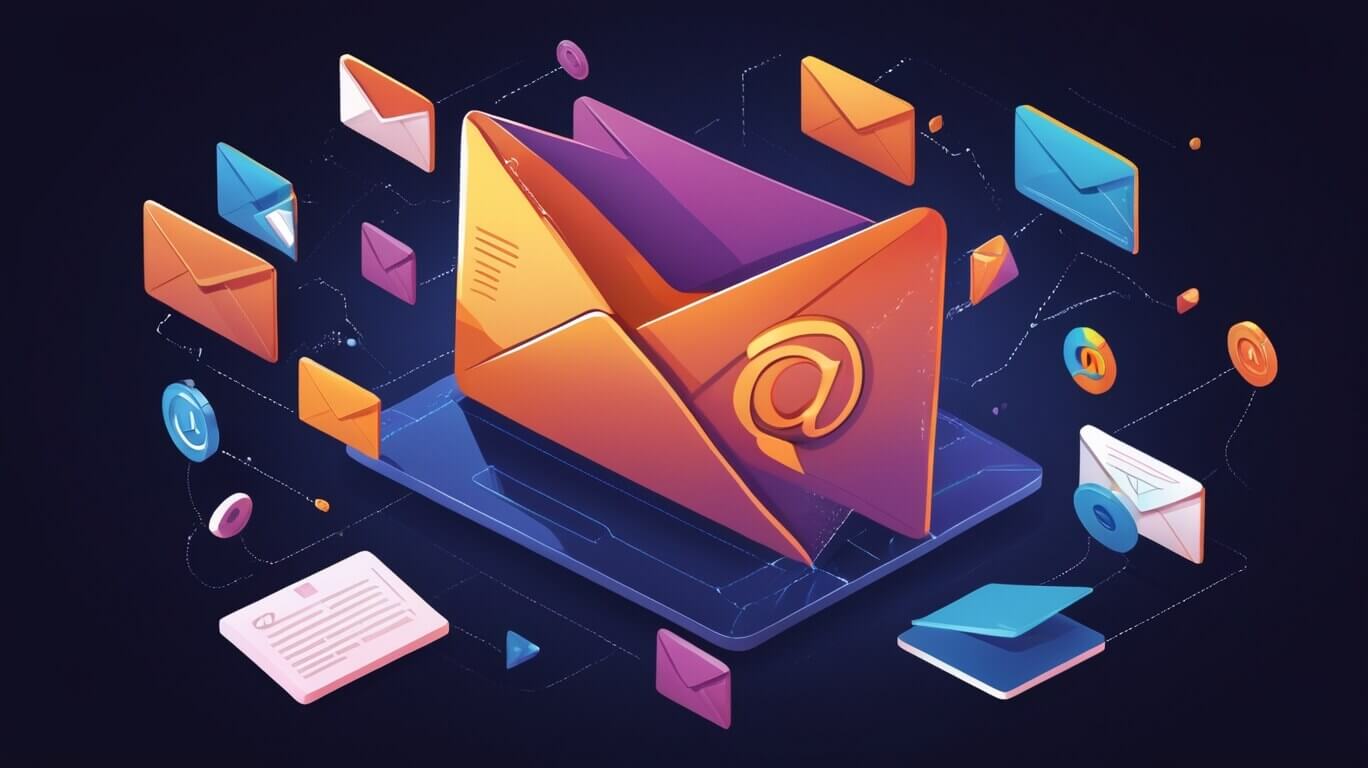
Maximize the Benefits of Email Marketing for Your Business
Get tips on how to develop a strong email marketing strategy to strengthen your customer loyalty, boost your sales, and build your online presence. From creating an email list to measuring the performance of your campaigns - we cover all the important aspects that are crucial for successful email marketing.
Inhaltsangabe
Building an Email List
- Create a sign-up form on your website to collect email addresses from customers and potential customers.
- Offer incentives to motivate customers to sign up for your newsletter, e.g., discounts or exclusive content.
- Use lead magnets, such as eBooks or webinars, to get customers to provide their email address.
- Make sure your sign-up forms are mobile-optimized so customers can fill them out on their smartphones.
- Use social media to grow your email list. Share your sign-up forms on platforms like Facebook, Instagram, and Twitter.
- Host giveaways or contests where participants must provide their email address to enter.
- Use pop-ups or slide-ins on your website to encourage visitors to sign up for your email list.
- Use a double opt-in process to ensure that the email addresses you collect are valid and that customers are actually interested in your emails.
- Make sure your sign-up forms are GDPR-compliant by providing a privacy policy and offering customers the option to unsubscribe from your email list.
- Use an email marketing service, like Mailchimp or Constant Contact, to organize and manage your email list.
- Regularly check your email list for inactive or invalid email addresses and remove them to ensure your emails are actually being read by interested customers.
Creating High-Quality Emails
- Use an appealing subject line to grab your customers' attention and get them to open your email.
- Ensure your emails have a clear and simple structure so customers can quickly find the most important information.
- Use high-quality images and graphics to make your emails visually appealing and capture your customers' interest.
- Use personalized salutations, such as the customer's name, to make your emails more personal and increase engagement.
- Keep your emails short and concise to ensure customers can read them quickly and grasp the essentials fast.
- Use Call-to-Action buttons to encourage customers to perform a specific action, e.g., visit a link to your website or buy a product.
- Make sure your emails are optimized for mobile devices, as many customers read their emails on their smartphones.
- Use consistent branding by including your logo, colors, and font in your emails to ensure customers recognize and identify with your brand.
- Use social proof by incorporating customer reviews, testimonials, or recommendations into your emails to gain your customers' trust and influence their purchasing decision.
- Use a clear sender, e.g., "Company Name Newsletter," to ensure your customers know who the email is from and why they are receiving it.
- Avoid spam trigger words in your emails, e.g., "free offers" or "buy now," to ensure your emails are not blocked by spam filters.
Personalized Email Marketing
- Use segmentation to divide your email list into different groups based on criteria such as age, gender, interests, or purchasing behavior.
- Create personalized email campaigns for each segment group to ensure the content is relevant and valuable to every customer.
- Use automation to send personalized emails based on specific trigger events, such as a customer's birthday.
- Use data and analytics to understand your customers' behavior and interests, and then create personalized emails that meet their needs.
- Use recommendation algorithms to suggest products to your customers based on their previous purchase behavior or interests.
- Use targeted email advertising by sending specific products or services to customers who have already purchased or shown interest in similar products.
- Use personalized signatures by incorporating the customer's name or other personal information into the signature to make your emails more personal.
- Use A/B testing to test different versions of your emails and find out which versions resonate best with your customers. This can help you optimize your emails and improve the performance of your campaigns.
- Use machine learning to optimize your email campaigns in real-time based on your customers' reactions and behavior.
- Use behavioral analysis to understand how your customers react to your emails and which elements work best for them.
Regular Communication
- Create an email communication plan to ensure you send your emails regularly and that you don't overwhelm your customers.
- Use a combination of automated emails, such as welcome messages and confirmations, and manual emails, such as newsletters and offers.
- Ensure your emails always have a clear purpose and are relevant to your customers. Avoid sending emails solely for the sake of sending.
- Use a combination of different email formats, e.g., text-based emails, HTML emails, or interactive emails, to engage your customers and capture their interest.
- Try to build a relationship with your customers by making your emails personal and making them feel like they are part of your community.
- Use a spam filter test to ensure your emails are not marked as spam and that they actually reach your customers.
- Review your email metrics to see how many customers open, click, and unsubscribe from your emails, and adjust your strategy based on this data.
- Ask your customers for feedback to understand what they think of your emails and how you can improve them.
- Experiment with different sending times and days to find out when your emails are best received by your customers.
- Look at examples of successful email campaigns to get ideas and find out what works for other companies.
Measuring Performance
- Use your email service provider's analytics tools to measure metrics such as open rates, click-through rates, unsubscribe rates, and spam complaint rates.
- Use UTM parameters in your email links to track how many customers visit your website and what actions they take on your website.
- Use A/B testing to test different versions of your emails and find out which versions achieve the best results.
- Use heatmaps to see where customers click on your emails and where they spend the most time to find out which elements work best.
- Use conversion tracking to find out how many customers perform a specific action on your website after receiving an email from you.
- Use your company's sales data to find out how many customers purchase something after receiving an email from you, and calculate the ROI (Return on Investment) of your email campaigns.
- Compare your email metrics with those of your competitors or industry standards to find out where you can improve and how you can differentiate yourself from the competition.
- Use feedback tools, such as surveys or reviews, to understand what your customers think of your emails and how you can improve them.
- Regularly review your email metrics and adjust your strategy based on this data to ensure you always achieve the best possible results.
Final Word: Challenges and Opportunities of Email Marketing
In this article, we've provided a practical guide to effectively utilizing email marketing for businesses. We discussed important aspects such as building an email list, creating high-quality emails, personalization, regular communication, and measuring performance.
Like any marketing strategy, email marketing also has challenges, such as spam filters, data protection regulations, and the ever-growing number of emails in customers' inboxes. However, email marketing also offers great opportunities to strengthen your customer loyalty and boost your sales.
We hope this guide has helped you get a better idea of how you can use email marketing for your business. By taking the tips mentioned in this article to heart and adhering to the best practices for email marketing, you can ensure your email campaigns are successful and that you realize the full potential of email marketing for your company.
What is Email Marketing?
Email marketing is a form of direct marketing in which emails are sent to customers and potential customers to inform them about new products, offers, and other updates and to encourage them to perform a specific action, such as making a purchase on a website.
Why is email marketing important for businesses?
Email marketing is a cost-effective and efficient way for businesses to reach their customers and promote their products. It helps companies strengthen their online presence and generate more sales.
What are the best practices for successful email marketing?
Some of the best practices for successful email marketing include building a high-quality email list, sending personalized emails, using A/B testing, and analyzing metrics.
What is a good open rate for emails?
A good open rate for emails depends on various factors, such as the industry, the company, and the size of the email list. Generally, however, an open rate of 20-30% is considered good.
How often should I send emails to my customers?
The frequency with which you send emails to your customers depends on what you are selling and how often your customers want to hear from you. Generally, you should send emails at least once a month to update your customers, but no more than once a week, as this could be considered spam.
What are the advantages of email marketing over other forms of marketing?
Some of the advantages of email marketing over other forms of marketing are the lower cost, higher efficiency, better target group reach, and the ability to personalize emails and measure performance.
What are the most important metrics I should monitor in email marketing?
Some of the most important metrics you should monitor in email marketing are the open rate, click-through rate, conversion rate, and the unsubscribe and spam complaint rate.
What is a lead magnet and how can it help me grow my email list?
A lead magnet is an incentive you offer to potential customers to encourage them to join your email list, such as an eBook, a webinar, or a voucher. Lead magnets can help you collect more email addresses and grow your email list.
What is a double opt-in process and why is it important for email marketing?
A double opt-in process is a procedure where customers receive a confirmation email after signing up for your email list and must click on a link in that email to confirm their subscription. This process helps you ensure that the email addresses you collect are valid and that customers are actually interested in your emails.
Looking for Shopware Extensions?
Here are our bestsellers!

Advanced Editor | WYSIWYG
Use the advanced WYSIWYG editor in Shopware 6. This editor enables easy embedding of media in descriptions and many additional features.
ab 7.99 €* / Month
Rent Plugin
Optimize PageSpeed
Optimize your shop to create a better experience for your customers. This plugin minimizes your shop’s loading time and offers numerous configuration options.
ab 27.49 €* / Month
Rent Plugin
Twig Manager
Quickly and easily create and edit your own template extensions in the administration. Displays existing storefront template paths and contents.
ab 3.99 €* / Month
Rent PluginNote: * All prices are exclusive of VAT
x
